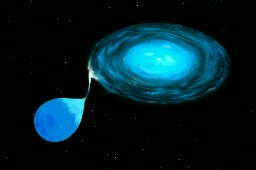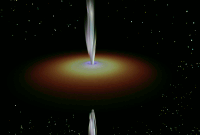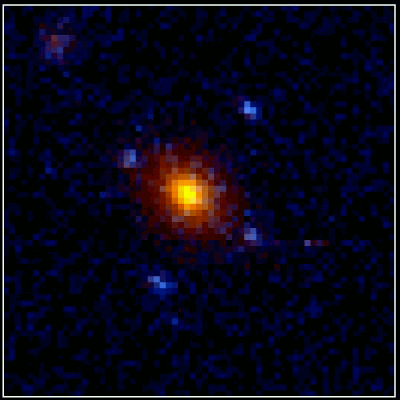The last stable orbit at 3Rs is the closest at which a material particle can orbit the hole; any closer in and the particle must move radially inward or outward. The photon sphere is the radius 1.5Rs at which gravity bends the path of photons so much that light orbits the hole circularly.
A Kerr hole is a spinning black hole. The single event horizon of a Schwarzschild black hole splits into an outer static surface and an inner ellipsoidal event horizon. Between the two surfaces is the ergosphere. At the static surface, it is necessary to move at the speed of light opposite the rotation of the hole just in order to stay still; further inward even light is dragged around with the hole. The no-hair theorem states that a static black hole is completely described by three quantities: mass, angular momentum, and charge, though a black hole would be unlikely to retain any electrical charge for long in the real universe.
Hawking radiation is the emission of particles (mostly photons) by black holes. Hawking radiation is blackbody and permits a temperature to be assigned to a black hole. The temperature leads to a thermodynamics of black hole and a definition of their entropy; black holes are found to have the highest entropy of any object in the universe. However, Hawking radiation is miniscule for all black holes of any significant size. Hawking radiation is a quantum effect, but exotic properties also come from classical (i.e. non-quantum) black holes. The throats of black holes could create wormholes, which might join two distant regions of spacetime. Wormholes also can have closed timelike paths associated with them, although it is unlikely that anything larger than a subatomic particle could traverse them. However, wormholes are dynamic and pinch off, making them useless for transportation, since anything in the wormhole would be crushed at the singularity. Another strange solution is the "white hole," which in many respects is the mirror image of the black hole; rather than matter disappearing into the hole, matter appears at a white hole, and nothing can remain in the white hole. However, there is no evidence that white holes could form in the physical universe. Black holes are created when massive stars collapse, or perhaps by the collapse of extremely dense star clusters at the center of galaxies, but white holes would have to be placed ab initio into the universe.
 Fig. 9.8: An
accretion disk in a binary system
Fig. 9.8: An
accretion disk in a binary system
Active Galaxies are galaxies that show energetic activity in their cores.
The best model for the "central engine" of active galaxies is a supermassive
black hole in the center of the galaxy. Around this hole a huge disk of gas,
an accretion disk , slowly spirals into the hole and releases
energy. 
Artist's conception of an accretion disk and jet in an active galaxy.
(Credit: Greg Foss, PSC)
The HST has looked deep into the heart of some nearby active galaxies. These galaxies exhibit jets shooting out from their cores at relativistic energies and speeds. One image shows the giant elliptical galaxy, M87, and the other shows the active galaxy NGC4261. A gravitational lens is produced when light passes through the enormous gravitational field of an object, such as a massive galaxy. In this image we see a background object lensed into four faint blue images surrounding a brigher red elliptical galaxy. Lenses such as these provide important cosmological data such as distances to very remote galaxies.
 A gravitational lens found by HST
A gravitational lens found by HST
Another gravitational lens is produced by a cluster of galaxies. The arcs are the distorted images of even more distant galaxies lying behind the cluster.
- What is meant by singularity? What is a coordinate singularity?
- What novel features do spinning black holes possess? How could an advanced civilization extract energy from a Kerr black hole? Why is this still not an infinite source of energy?
- When, if ever, is Hawking radiation important?